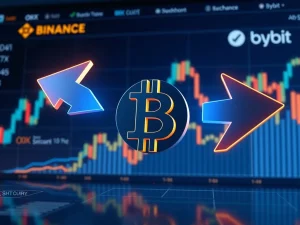FTX Liquidation Breakthrough: US Court Approves Vital Cross-Border Claim Transfers

The saga of the FTX collapse has been a long and challenging journey for countless investors worldwide. For months, creditors have grappled with the complexities of recovering their assets from the defunct crypto exchange. Now, a significant development from the U.S. Bankruptcy Court for the District of Delaware offers a beacon of hope, particularly for those in previously restricted regions. This pivotal ruling on FTX liquidation rules marks a crucial step forward, aiming to inject much-needed liquidity and fairness into the arduous recovery process.
FTX Liquidation: A Complex Web Untangled
When FTX, once a titan in the cryptocurrency world, dramatically collapsed in November 2022, it sent shockwaves across the global financial landscape. Millions of users found their funds frozen, trapped in a labyrinthine crypto bankruptcy proceeding. The initial stages of the liquidation process were fraught with challenges, not least of which were stringent restrictions on how claims could be transferred, especially for creditors residing in certain jurisdictions. These restrictions, while initially imposed to prevent fraud and ensure regulatory compliance, inadvertently created significant hurdles for legitimate claimants.
The original framework made it nearly impossible for creditors in designated ‘restricted jurisdictions’ to sell or transfer their claims, effectively locking their assets in limbo. This meant that while some creditors could navigate the claim market, others were left with no immediate options for recovery, deepening their frustration and financial distress. The sheer scale of the FTX collapse, involving entities across numerous countries, made a unified and equitable resolution incredibly complex.
Unlocking Liquidity: The Power of Cross-Border Claim Transfers
In a landmark decision on July 23, 2025, Chief Judge Karen B. Owens led the U.S. Bankruptcy Court to amend its prior motion, opening the door for creditors in restricted jurisdictions to engage in claim transfers across borders. This revision is a game-changer for many, as it directly addresses one of the most significant pain points in the recovery process.
So, what does this mean in practical terms? Previously, if you were a creditor in a jurisdiction like Singapore or the UAE, you might have found yourself unable to participate in the burgeoning secondary market for FTX claims. Now, you can:
- Sell Your Claim: Creditors can now sell their claim to a third-party debt buyer, often at a discount, but providing immediate liquidity rather than waiting years for the full recovery process to conclude.
- Enhance Market Liquidity: This influx of eligible claims from previously restricted areas is expected to invigorate the overall market for FTX claims, making it more dynamic and efficient.
- Bypass KYC Hurdles: While the process still requires verification, the ability to transfer claims helps circumvent some of the prolonged delays caused by stringent Know Your Customer (KYC) requirements and diverse regulatory frameworks in regions like the Bahamas and China.
This move is particularly impactful given that approximately $290 million in approved claims remained unpaid due to these very compliance hurdles. As creditor representative Sunil Kavuri emphasized, “This is an essential step for creditors in restricted jurisdictions seeking to recover losses without facing automatic confiscation.” It provides a much-needed pathway for those who felt their recovery options were nonexistent.
Navigating Restricted Jurisdictions: A Path to Creditor Recovery?
The revised “Restricted Jurisdiction Procedure” is designed to determine eligibility for future payouts in the 49 identified restricted countries. This isn’t a free-for-all; FTX will still seek legal opinions to assess whether distributions comply with local laws in these regions. While this framework might slow immediate disbursements as these legal assessments take place, it establishes a clear, albeit methodical, pathway to creditor recovery.
The challenges in these restricted jurisdictions have been manifold:
- Varying Regulatory Landscapes: Each country has its own unique set of financial regulations, anti-money laundering (AML) laws, and KYC protocols, making a one-size-fits-all approach impossible.
- Jurisdictional Disputes: The interplay between the U.S. bankruptcy court and local authorities, particularly in places like the Bahamas where FTX had significant operations, has been a source of ongoing complexity.
- Legal Precedents: The court’s approach mirrors processes seen in prior, high-profile crypto collapses such as Mt. Gox and Celsius, where international claim resolution also took years. This precedent suggests that patience will still be required, but the direction is now clearer.
For instance, some Bahamian claimants have already received verification under a separate legal process, indicating that progress, albeit incremental, is being made. The settlement between FTX’s Bahamas unit and Celsius Network over clawback claims also highlights ongoing efforts to unlock frozen assets, demonstrating the interconnectedness of these complex legal battles.
Market Dynamics and the Future of FTX Claims
The market’s reaction to this news has been cautiously optimistic, especially among creditors and debt buyers in Asia and the Middle East. These regions, home to a significant number of FTX claimants, stand to benefit immensely from the improved recovery flexibility. Analysis by Coincu notes that these regulatory shifts are poised to invigorate asset recovery processes and stimulate trading interest among debt buyers. The enhanced cross-border claim transfer mechanisms are expected to diversify liquidity channels for creditor claims, which could have broader implications for global market dynamics within the distressed crypto asset space.
The ability to transfer claims allows for a more efficient allocation of capital and risk. Investors who specialize in distressed assets can now acquire claims from individuals who prefer immediate, albeit discounted, payouts. This creates a functioning secondary market, which is a hallmark of mature financial systems, even in the context of a crypto bankruptcy. This mechanism not only benefits individual creditors but also provides a more robust framework for handling large-scale digital asset insolvencies in the future.
Regulatory Rigor vs. Equitable Distribution: The Ongoing Challenge
The FTX case continues to highlight the delicate balance between regulatory rigor and equitable asset distribution. PricewaterhouseCoopers (PwC) and Bahamian King’s Counsel Brian Simms have been instrumental in managing the case under strict compliance protocols. While stringent compliance measures are crucial for mitigating systemic risks and preventing illicit activities like money laundering, they have, at times, inadvertently slowed recovery for legitimate claimants.
The court’s decisions in the FTX case are not just about resolving one bankruptcy; they are setting critical precedents for future crypto bankruptcy cases in a rapidly evolving regulatory landscape. The interplay between international legal frameworks, national sovereignty, and the borderless nature of cryptocurrencies presents a unique challenge for courts worldwide. The upcoming court sessions on August 12 and September 11 will further clarify the scope of these restrictions and their long-term impact on the overall liquidation timeline. These sessions will be closely watched by the entire crypto community, as they will undoubtedly shape how future digital asset insolvencies are managed.
The U.S. Bankruptcy Court’s decision to revise FTX liquidation rules for cross-border claim transfers is a monumental step forward. While the path to full creditor recovery remains long and complex, this ruling offers a tangible mechanism for thousands of affected individuals to regain some control over their frozen assets. It underscores the ongoing evolution of legal frameworks adapting to the unique challenges of the digital asset space, promising a more structured and equitable approach to crypto insolvencies in the future.
Frequently Asked Questions (FAQs)
1. What are the key changes in the FTX liquidation rules?
The U.S. Bankruptcy Court has revised its restrictions, now allowing creditors in previously ‘restricted jurisdictions’ (such as Singapore, UAE, Bahamas, and China) to transfer their FTX claims across borders. This aims to enhance liquidity and provide more recovery options for these claimants.
2. Which jurisdictions are considered ‘restricted’ under the new rules?
There are 49 jurisdictions designated as ‘restricted.’ These typically include countries with complex or differing regulatory frameworks, or those where initial compliance hurdles were significant, such as the Bahamas, China, Singapore, and the UAE, among others.
3. How does this impact FTX creditors, especially those in restricted regions?
For creditors in restricted regions, this change means they can now potentially sell their claims to third-party debt buyers, gaining immediate, albeit discounted, liquidity. It provides an alternative to waiting for the full, often years-long, recovery process to conclude, addressing a major pain point caused by initial KYC and regulatory delays.
4. Why were these changes necessary for the FTX liquidation process?
The changes were necessary to address prolonged delays and inequities caused by stringent KYC requirements and diverse regulatory frameworks in various countries. Over $290 million in approved claims were held up due to these hurdles. The revised rules aim to facilitate a more equitable and efficient distribution of assets by allowing a secondary market for claims to function globally.
5. What are the next steps in the FTX bankruptcy case following this ruling?
Following this ruling, FTX will seek legal opinions to ensure that distributions comply with local laws in the 49 restricted countries. Upcoming court sessions on August 12 and September 11 are scheduled to further clarify the scope of these restrictions and their long-term impact on the overall liquidation timeline. The process is expected to continue for some time, mirroring the lengthy resolution times seen in other major crypto bankruptcies like Mt. Gox and Celsius.









